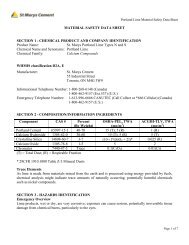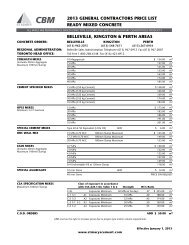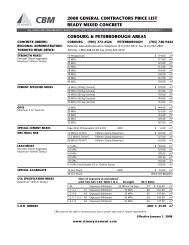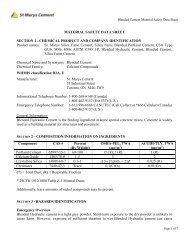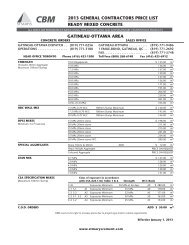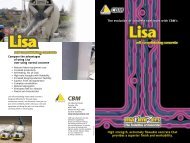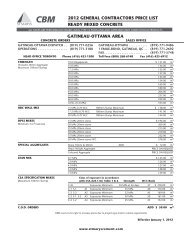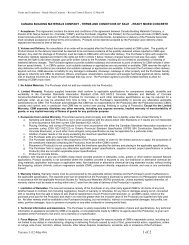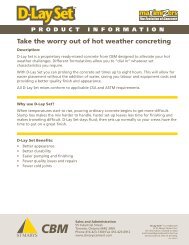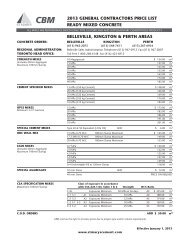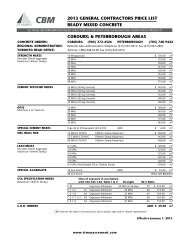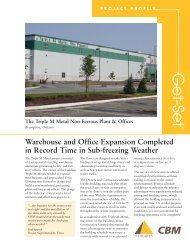Detroit Grinding Plant Brochure - St Marys Cement
Detroit Grinding Plant Brochure - St Marys Cement
Detroit Grinding Plant Brochure - St Marys Cement
- No tags were found...
You also want an ePaper? Increase the reach of your titles
YUMPU automatically turns print PDFs into web optimized ePapers that Google loves.
The clinker is dry when it is off-loaded from theship. It is kept moisture free and dust isprevented from escaping in a huge A-framefacility. The raw material is transferred into thebuilding on a conveyor system suspended fromthe ceiling and later taken out of the buildingthrough a vibrating belt conveyor system beneaththe floor.Slag granules are also shipped by lake freighter tothe plant, but it is still damp when it arrives andcan be stacked outside. Before being transferredto the mill, the raw material is sent through apreliminary crusherand then a gas dryer toevaporate most of themoisture it contains.The A-frame storage building for clinker (top left and above)seems only fitting for a company with a pyramid logo.Slag granules and other raw materials (bottom left) are stackednear the unloading facility.In their original state (right), clinker ranges in size from thatof a large pea to that of a golf ball, while slag granules (farright) are more like course sand.
The safety and health of our employees, neighborsand the local community is of primary importanceto <strong>St</strong> <strong>Marys</strong> <strong>Cement</strong>. The company is committed tothe protection of the environment, complying withall environmental laws and regulations and tocontinuous improvement in the environmentalperformance of the operation. The company is alsoconstantly seeking improvements in energyefficiency through good management practices.<strong>St</strong> <strong>Marys</strong> <strong>Cement</strong> Inc. (U.S.) is a leader insupporting the local community in which it doesbusiness and is aware of its responsibilities. It is alongstanding member of the Southwest <strong>Detroit</strong>Business Association, the <strong>Detroit</strong> Regional Chamberof Commerce and the Southwest <strong>Detroit</strong>Environmental Vision, giving generously to theirsupport.<strong>St</strong> <strong>Marys</strong> introduced a procedure of wetting downall road surfaces within the property and washingall trucks to reduce particulate matter while futureplans call for either paving or planting the entireproperty.<strong>St</strong> <strong>Marys</strong> <strong>Cement</strong><strong>Detroit</strong> <strong>Plant</strong><strong>Cement</strong> tankers are required to move through a high-pressurewash facility before leaving the plant.DETROIT PLANT9333 Dearborn, <strong>Detroit</strong>, MI 48209Telephone 800-462-9157w w w. s t m a r ys c e m e n t . c o mTERMINALSBuffalo, NY • Cleveland, OH • Columbus, OHSchoolcraft, MI • Grand Rapids, MIWaukegan, IL • Milwaukee, WI • Green Bay, WI2500/6-02 PRINTED IN CANADA
The production of Portland cement is a multi-stageprocess. It involves quarrying, crushing andgrinding limestone with much smaller quantities ofclay and sand. Subsequent firing of these materialsin a kiln at approximately 2,700°F. converts theminto an entirely new chemical product - smallpellets called clinker. For the <strong>Detroit</strong> <strong>Plant</strong>, this firstpart of the process of making Portland cement nowtakes place at <strong>St</strong> <strong>Marys</strong> <strong>Cement</strong> plants in Ontario,Canada. When cooled, the clinker is loaded ontoships for the trip to <strong>Detroit</strong> via the <strong>St</strong>. LawrenceSeaway and also into trucks.The <strong>St</strong> <strong>Marys</strong> <strong>Cement</strong>, <strong>Detroit</strong> <strong>Plant</strong> is a grindingfacility. It receives clinker from the freighters, whichdock at its marine facility on the Rouge River, offloadingapproximately 27,000 tons at 1,800 to2,000 tons per hour. A unique, specially designeddust free off-loading system was developed just forthis purpose.The plant also grinds a product called CemPluswhich is primarily ground, granulated blast furnaceslag or GGBFS. When blended with Portlandcement, the concrete it produces is a stronger andless permeable concrete with greater chemicalresistance. CemPlus is a by-product of iron smeltingand considered an environmentally friendlyproduct. In providing a beneficial use of anindustrial by-product, CemPlus reduces the energyrequired to produce concrete while at the same timeimproving its performance.Canada <strong>St</strong>eamship Lines lake freighter Frontenac plies theGreat Lakes from Chicago to Kingston and all points inbetween. The <strong>Detroit</strong> <strong>Plant</strong> is located on the Rouge Riverwhich joins the <strong>Detroit</strong> River as it empties into Lake Erie. Thepictures at the far right and above right, show the dust-freeunloading of clinker at the <strong>Detroit</strong> <strong>Plant</strong>’s dock.The majority of product produced at the <strong>Detroit</strong> <strong>Plant</strong> is eitherPortland cement or CemPlus.Portland <strong>Cement</strong>CemPlus
The entire handling process is controlled from oneroom in the main office building. Computersmanage the process and skilled techniciansmonitor the production. Working closely withquality control using industry standard testingmethods, different cement products are formulatedusing various materials and additives in differentquantities.Quality in cementproduction is not anaccident. Every person inthe plant is responsiblefor maintaining qualitybut constant testing bythe technicians in thequality controldepartment assures theuniformity ourcustomers demand.A rubber belt conveyor movesslag granules to the dryerwhere moisture is removedbefore the grinding processbegins.Curtis Henderson, Control Room Operator oversees thecomputer controlled operation of the plant.Wet granulated slag, stacked outside, is moved to the conveyor feed.
The final stage of Portland cement production isknown as finish grinding. The process involvescrushing and grinding the clinker in one of threeball mills . . . huge rotating, horizontal steelcylinders containing steel alloy balls in threechambers. The clinker is ground into powder so fineit will pass through a sieve that could hold water. Asmall amount of gypsum is added to regulate thesetting time of the cement. Other chemicals, such asthose that regulate flowability or air entrainment,are also added at this stage.Two of the ball mills are dedicated to grindingPortland cement while the third is used for grindingCemPlus. The grinding process occurs in a closedsystem with a separator that divides the cementparticles according to size. Material that has notbeen completely ground is sent through the systemagain. <strong>Grinding</strong> causes friction however, which inturn creates heat and it is necessary to cool thefinished product before sending it through acompressed air system over to the storage silos.Two of three ball mills (top) pulverize the raw material withsteel balls. The process is regarded as the most dependable andtrouble-free method of grinding cement.<strong>St</strong> <strong>Marys</strong> <strong>Cement</strong> is owned by Votonatim Group,one of the largest private industrial conglomeratesin Brazil and a leader in most of its businessmarkets, particularly in the cement, pulp and paper,and metals and mining industries.www.votorantim-cimentos.com.br/eng/Huge storage bins above theplant provide a constantsupply of clinker.<strong>Cement</strong>, which gains heatduring production, is watercooled before it is moved tostorage.Chris Weiss (right) and Chad Richards are just two membersof the team of experienced technicians working on-site withinour cement and concrete laboratories. A constant round ofquality control tests assure consistently high quality products.
The <strong>Detroit</strong> plant has a substantial finished productstorage capacity in 18 main silos, which whencombined with day-to-day production is enough toprovide a steady supply of product during the busyseason. Most of the Portland cement is distributedin bulk to ready mix concrete customers with somegoing to <strong>St</strong> <strong>Marys</strong> <strong>Cement</strong> terminals in Michigan,Illinois, Ohio and Wisconsin by truck and rail car.For easier handling in small quantities, masonryand mortar cement is packaged in bags with thefamiliar <strong>St</strong> <strong>Marys</strong> pyramid logo on the face.As the hub for U.S.operations, the plant is thecentral office for a dedicatedteam of sales, marketing andadministrative staff includingpayroll, accounting, humanresources and IT.Above is Pat Timm, HRBenefits and Payroll Coordinator.<strong>Cement</strong> tankers (left), move to safety stations for securing ofthe hatches before leaving the plant.Joe Hogan, Vice PresidentLogistics oversees theshipment of product tomarkets from Wisconsin toEastern OntarioA tanker is closed up afterloading.Pallets of bagged product arestacked in the warehouse byChris CurtisHarry Robinson operates thebagging machine.Masonry and mortar cements of various types are the commonbagged products packaged at the <strong>Detroit</strong> <strong>Plant</strong>. They areshipped out on flatbed trucks stacked high with bags on pallets



